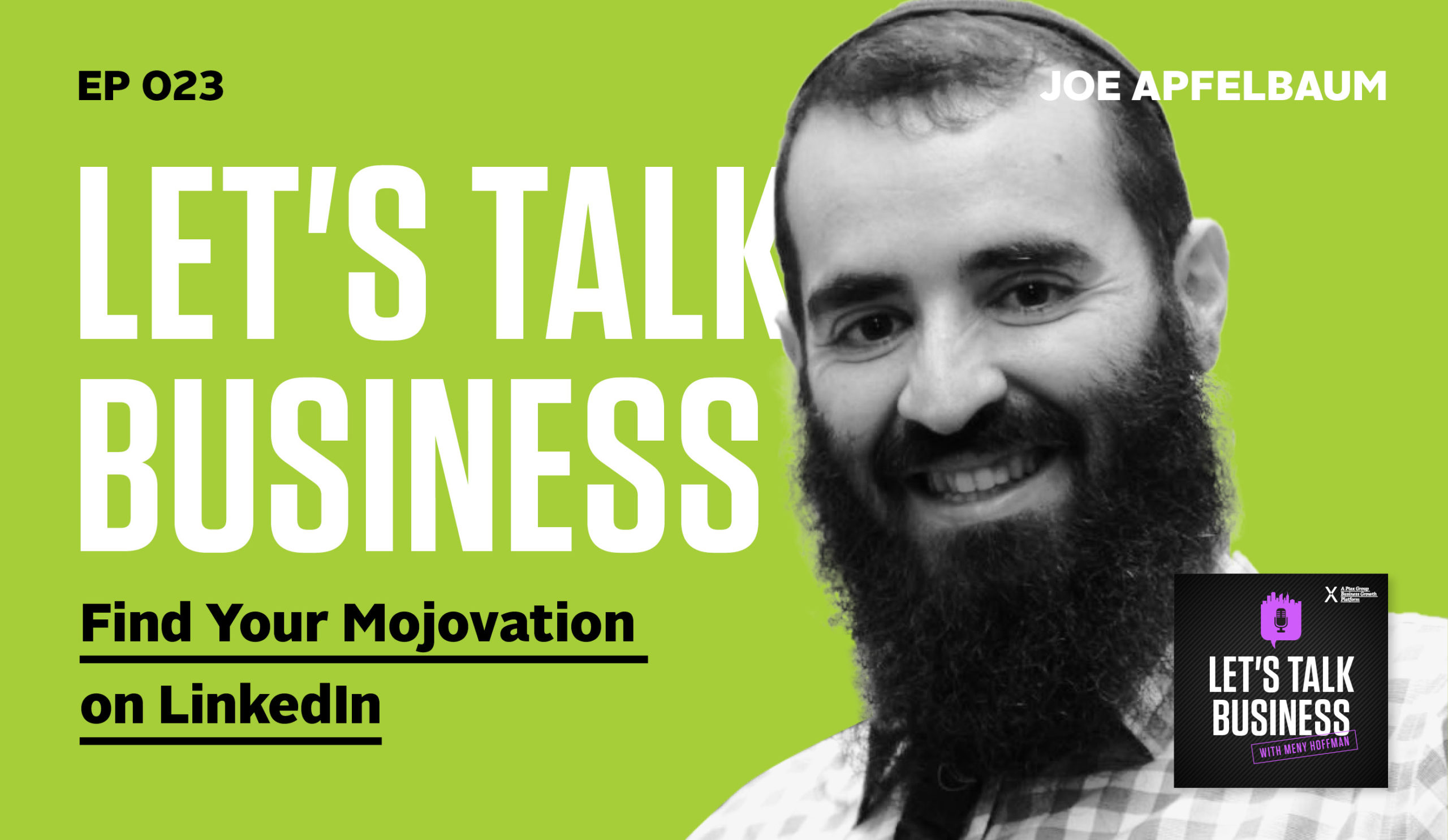Scaleology founder Bill Prater talks to Meny Hoffman about the essentials of business growth and why adhering to “best practices” does not contribute to it.
Best practices are overrated. For years we have been taught that the key to business growth is following methods that have been proven over and over again in your industry. However, a quick look at the elite rungs of any industry will show you that what binds the top players together is their penchant for being different, even outrageously so. Suffice it to say that if you want to break the barriers to your growth, you don’t want to be lumped among the ordinary. Few people understand this better than Bill Prater, founder of Business Mastery and Scaleology. In this conversation with Meny Hoffman, Bill unpacks the essential things that business owners need to keep in mind as they prepare to scale. He also shares practical advice on how leaders can bring their team onboard with their vision. Join in and stick to the end as Bill shares a ton of important information and incredible resources.
Listen to the podcast here:
Download the audio file here.
Why Best Practices In Your Industry Are Keeping You Small—With Bill Prater
Our guest is Bill Prater. He is the Founder of Business Mastery and Scaleology. He loves nothing better than sharing what he has learned by working with those who are dissatisfied with the status quo and eager to transform themselves and their business. That’s exactly what we discussed in this episode. We went through the mindset of a leader and how they grow your business, if you don’t have the proper mindset, what are the practical advice and how you could achieve them. Pay also close attention to how Bill shares how a leader could bring his team along the ride and explaining to his team the proper vision. Finally, pay close attention to the practical tips that Bill provides for a system and a model of growing a company and what you need to know as a leader. Without further ado, here’s my interview.
—
Bill, thank you so much for joining me on the show.
I’m super delighted, Meny, to be here with you.
We have known each other for quite some time. We’re in a group together where we both sharpen our soul and get a little bit better at what we do on a daily basis. I got to speak to you on lengthier conversations. We had multiple conversations. I resonated with a lot of what you do and what you bring to the marketplace in terms of business growth, business mindset and the way you approach it. I figured what better than bringing you on the show so all our readers could learn from you directly and, ultimately, get some no-nonsense advice.
I’m very flattered. I look forward to talking with you, Meny.
Bring us up to speed with your professional journey. How do you got into what you’re doing? What was your past? A little bit of what you do.

Three or four phases. The first one, right out of college, I was getting a corporate job with a giant company called IBM. At IBM, I was a systems engineer, sales rep, sales school training instructor and then a sales manager. I had those four jobs in years. Ultimately, I decided that I wanted freedom, which if you will the lure of freedom of being on my own with my own business. That got me to leave IBM and get involved with a privately-held entrepreneurial company. Since then, I’ve had many different companies, many of which I’ve subsequently sold several of them. That journey got me finally to a major turning point when I found an investment banking firm headquartered in Seattle but 95% of our employees were on Wall Street in New York City.
Our clients were purposely selected to be low technology, small to medium-sized private businesses. I capitalized on low technology because the investment banking world, at the time that I founded that company was focused on high technology. I thought, “I’ll go low technology and find a niche there,” and I did. Generally speaking, these were people that owned businesses that were boring. By that, I mean they manufactured and sold baby diapers, fertilizer, they’re in a small chain of restaurants or they were involved in alternative energy power plants. The list went on and on but they were all what I’ll call boring. No outsiders will get excited about making fertilizer but they needed capital. We were in the capital-raising business. I looked at u as being a store where people came and asked for capital. If they had a compelling enough story, we would loan it to them and invest with their company or some other form of a capital infusion.
Bringing us to where you are now, you curated this model that you’re bringing to the world that you see working. Share with us a little bit about how you got to that.
That circles back to the investment bank. What I discovered or experienced is that, over time, we had a large portfolio, about $2 billion invested in little chunks. I envisioned $5 million to $50 million chunks. It all added up. We’re up on $1 billion and $500 million. I became more of a curator of these investments than creating brand new ones. I became worried about how our investments were doing. As a result, two things happened. One, I wanted to get out of the business but discovered that I had an ordinary, regular investment banking firm. I used that ordinary, regular. I’ll come back to that.
Second, I could see that, in general, the companies we’d invested in were very diverse. I gave you several examples. They all ran their businesses differently. I had a hard time trying to keep track. It drove me crazy. I decided, “I got to sell my company but nobody wanted to buy it.” Why? It’s because it was ordinary and regular. I did what most business owners do. You didn’t talk about this in the past. That is, you go and look at the industry best practices, industry standards or industry norms. All of those words, as I look back on it now, I realized what I was doing was looking at what the average player in the industry did. Emulating those things will create an average player in your niche. That’s what happens when you follow the standards.
One day, I had a chance to talk with an investment banking competitor who had a small but elite, well-known firm. I was talking to her. I told her what my goal was, which was to sell my business. I told her what I was doing to solve my problems. Number one, industry. Number two, I happened to know a lot of consulting firms. They’re largely in New York. I went and visited these big consulting firms and they said, “We don’t help people manage their businesses. We help them do projects like install Oracle or help them with Salesforce software, ” or something like that. That’s what consultants do. They’re project-oriented. The third place I went was I knew several business school deans, major, giant business schools, famous ones, Sloan’s, Stanford, etc.
I went to see these deans and told them what I needed, “I needed help running my business.” They said, “We turn out employees for a company. They’re called MBAs. They’re great employees but we don’t teach anybody how to run a business.” I then started reading all kinds of business books. I discovered everything in business books came from publicly available information, publicly-traded companies that published a bunch of stuff. If you go back and read some of those business books that I was reading back when I had my investment bank, things like Good to Great, if you go look at the companies that were listed as being great, two-thirds of them quickly went bankrupt or out of business. That was the wrong place to look.
[bctt tweet=”What sets elite players apart is that they think differently. They don’t copy the masses.” via=”no”]
This woman that I’ve talked to said to me, “Bill, you’re looking in the wrong place. You’ve got to look at what the elite players are doing in your industry, people like me. I don’t do anything at all like what the rest of the industry does. I do things differently.” I said, “That’s great. Tell me.” She said, “Bill, the truth is that the elite players in every industry are more like me than they are like the average player in their industry.” She gave me several people to go talk with and visit with. I knew some of them. Some of them were famous types of folks like Steve Jobs, who was in the computer industry but did not look at all like anybody else in the computer industry the way he ran his business. Now, there are examples like Elon Musk, certainly Richard Branson. These people don’t operate like ordinary airlines or automobile manufacturers. They operate differently.
What I discovered is that I needed to have an entirely different mindset and different way of looking at investment banking. That was part one of what the elite players do is think differently. Don’t copy the masses. Copy the elite or emulate the elite. Number two, all super high-quality, high-performing elite players in every niche operate their businesses systematically. They have a management system in place. I ended up creating a management system. I hobbled together things that I could see people are doing and created what I wanted from my own firm. I’ll circle back to that. The third thing, virtually, all of these owners of elite companies do in common is none of them are involved in the day-to-day of their business. Instead, they’re almost like an investor. When you look at them, they’re the visionary of their company. They’re the ones who are building the high-level strategies of their companies but they’re not the ones running their business day-to-day. Instead, they hire A-players out of that, develop elite teams of management and leverage those teams.
The model that I created from my investment bank had three pillars: mindset, system and team. I was able to move my business from ordinary to something that people fought over trying to buy from me. In 2.5 years, it made an incredible change in a very short period of time. I used the same model and philosophy with my own portfolio. I literally went into my portfolio. I met with the CEOs and owners of these companies that I had invested in. I told them that they needed to change the way they manage their company and manage it the way I wanted them to. When somebody is asking you for money and you say, “I’ll give it to you but the rule is you’ve got to run your business the way I tell you,” they all say yes. It’s amazing how that works. I was able to turn my investment portfolio into something that performed at extremely high levels as these companies that I was working with started to flourish. When I sold my firm in 1999, I continued to work as a mentor, coach and facilitator for the same small to medium-sized business owners.
Let me ask you a typical question. You have been seeing many entrepreneurs, leaders and companies growing businesses. Many of us have seen that some of them are having tremendous success, and then some of them are dabbling and not moving in any direction. What would you say is the key difference between those two leaders that we could explain to the readers what you’ve seen? What makes a great leader in the company growing versus standing still?
It relates to this concept of mindset. The biggest single difference is that the companies that are performing at a very high level and they have a long-term vision, at least 5 maybe 10 years or longer. The vision they have for the company is viewed by many people as being outrageous, crazy, whatever. In fact, what I’ve seen is the more outrageous and extraordinary somebody’s vision is, the more likely they are to achieve it. The reason for that is the people who believe in the dream, those people, customers, vendors and suppliers, employees who are attracted to the vision are exactly who you want to attract. The people who think you’re full of it, those are the people you want to reject. The key is to attract people to you, customers, clients, vendors, suppliers, contractors and employees who believe that your dream is not that outrageous.
We speak about mindset. How much and how is that playing a role? How do you see the transformation of a leader where they have to develop that mindset?
We’re talking about skill versus talent. What I mean by that is that’s something that you can learn. Oftentimes, people will say to me, “Bill, when I founded or acquired the business, I did have a dream but then reality set in. I realized how hard it was, so the dream dissipated. It’s no longer there. I don’t know how to do it again.” If you think back to when you were five years old and you were in kindergarten, you and everybody else in the class could dream. It’s deciding to think like a kindergartener who doesn’t think within any boundaries. Step one is to think outside of the boundaries. First off, the entire planet is involved in the pandemic that’s going on now. Many people have allowed it to affect their lives very badly, their businesses, personal lives, health, etc. They’ve bought into that pressure.

On the other hand, there are people that are having an entirely different mindset thinking, “This is a serious circumstance but I’ve seen a serious circumstance many times before.” It starts with thinking outside regardless of the environment. Once you are able to put those restrictions aside, then it releases you to be able to dream. You can think of vision and dream as being very similar things. The commonality between dreams and visions is they don’t have to be in any way connected to reality. They’re literally a dream. Anybody that’s able to somehow invent something isn’t dealing with reality because what they’re going to invent shortly down the road doesn’t exist now.
If a person wants to get better at it, what are the steps? This is something that they could learn and get better at. What are the steps you would advise a leader to get into if they want to get the proper mindset?
The point is to ask yourself, “How can I get out of the environment that I’m in?” Sometimes it involves removing yourself physically. By that, leave your place of business, leave your office and go someplace else. For example, go sit by a stream, rent a boat and go out into a lake or go on a hike through the woods, any place that’s dramatically different than your environment. When you’re there, just sit in and think, “If I didn’t have any restrictions at all, what would be possible?” Not probable but possible. Step one is to physically remove yourself from your environment. If you’re talented, you can sit in your own chair and do it but I personally prefer going someplace else. That’s step one.
Step two, I feel that there are two approaches for step two. One is to transport yourself into the future. Pick a date, an actual date, five years or so down the road and say, “I’m imagining myself five years from now addressing my stakeholders, shareholders, employees, customers and vendors. I’m in front of this room and I’m going to talk to them.” You can start off by saying something like this, “Five years ago when I started this journey, I never thought I’d be where we are now. Now, we’ve won the Best Places to Work in New Jersey.” Start thinking about all the things that could have happened, “We’ve won this. We’ve grown X times in revenue. We’ve had two of our employees be awarded the highest honor in our industry.” Go on and on.
One technique is to go into the future. Pretend you’re making a speech. The speech would be a summary of what happened. That’s one way. The other one is to start now and say, “I’m imagining that in five years, we will have grown our revenue seven times. We will now have grown from a seven-person operation to one that’s got 50 employees, but our revenue per employee has gone up five times.” Two ways. One, think about being in the future making a report on the past. Two, thinking about, “When I get to the future, this is what will happen.” Step one, new environment. Step two is to start building this story. The reason I use the word, story, is that you don’t want it to be a vision statement like, “We’re going to be the number one accounting firm in New Jersey.” That would be made potentially a vision statement but that’s not what I’m talking about. It’s a story.
The reason you want it to be a story is that it always changes. It’s always slightly different. You want it to be always slightly different. When you see people and you’re going to tell them your vision again, they’ll be wondering, “What are you going to say now?” It’s a rightful thing to be able to change your story because one day has gone by, things are different or weeks have gone by or months have gone by since you’ve seen this person. You can say, “Since I last saw you, I thought we could probably grow our business seven times but I revised that. Now, we should be able to grow it 10X in the next seven years.” That’s why it should be a story.
Let me ask you. Something that I know that a lot of leaders are challenged with is sometimes the leader starts making progress and they grow but ultimately, they now need to cast that vision. They need to be able to bring along the existing team members. How do you make sure that there is a process, an easy way on how you could get your team on board? Without the team, you cannot achieve what you’re planning to achieve.
[bctt tweet=”The more outrageous your vision is, the more likely you will achieve it. ” via=”no”]
This is a hard transition for many people. If you think about your team, generally they come along with 2 or 3 other people. If you’ve got ten employees, you could very well have 35, 40 or 50 people depending on you as the employer. Here’s the story. If you think about sports and you happen to be the coach of a Little League Girls’ softball team, you’re the coach of that. You decide in your vision that you’re going to move to become a high school women’s softball coach. The truth is, all of the players on your Little League team will not be suitable for your high school softball team. What I mean by that is as your vision changes, grows and gets bigger, you’re going to have to leave some of your players behind if they can’t keep up, number one. Number two, you’re going to have to be continually top-grading or upgrading your team as your vision grows. As you decide to move from coaching a high school girls’ softball team to a collegiate one, some of the women that were on your high school team will not make it to the college level.
The quick answer is that’s another value of having this vision because people will opt-out. By that, they’ll say to you one day, “Sally, I’m hearing your vision. I don’t see myself being in your company when you get to that point because I don’t want to go there.” They won’t use those exact words but they’ll opt-out. If they don’t, you’re going to have to understand that some people can be trained to grow at the speed you’re going and some can’t. There are always new people. I believe in what I call top-grading. In simple terms, every single year you should be adding A-players to your MIS. Typically, they’ll come from outside. At the same time, some people, let’s say the bottom 5% of your team, may have to be shown the door. What I mean by that is some people are great ballerinas or ballet dancers but they’re not necessarily good softball players. It’s your job as the owner to help people find their own path. It may or may not be with you.
There’s this line that I use a lot. I use it mainly when we hire people. I always remind them when we get to winding down for whatever reason with an employee, I say, “You’re getting hired for this company. You should know that there’s going to come a time that either you outgrow the company or the company outgrows you. My goal is, while you’re here, you’re having a great time. You’re being an asset and valued and bringing value and so on.” You’ve got to know that, at one point, either the person outgrew the company and the opportunity and they want to move on to a new opportunity or the company has grown to a level where the company needs somebody stronger or different than the current person in that role.
I think it’s a very important point. People see this as negative sometimes when a person has to be let go or a person wants to move on from your company. It shows that you have a strong company. It shows that you have a great culture. You’re able to build those people to a level where either they want to move on to something else, do something bigger or the competency is growing to a level that that person is not the best fit for it.
The third one is that the people do grow along with the company and they continue to be a good fit. I love the way when you onboard somebody that you say exactly that to them, “You’ll outgrow, the company will outgrow or we’ll grow together.” Those are the three choices. It’s my job to make sure that I keep you posted on how you’re doing at all times. I’d like you to tell me when you think, “Meny, I’d like you to give me a great letter of recommendation because I’m seeking a new pasture.” That is beautiful, I love it.
It also reminds me I was once at an event where there was one large company that was about to go public. They didn’t go public as of now, a larger company that has grown to 600 and something employees. It was right after they let go a couple of C-level executives in the company. The CEO was humble enough. He came on stage. He was addressing a lot of partners and people that work with them that they felt what’s happening in the company. He shared that, “The leaders have been great for our company. They brought us to the level where we needed to be. It takes a different skillset for somebody that’s bringing a company from $5 million to $10 million, $10 million to $20 million or $100 million company. We just need to bring in people that could move us up from $50 million to $100 million at this point. We’ll forever be grateful for those people.”
He humbly said, “If I’m not going to live up to my expectations, I’ll also be fired by the board. The CEO has a responsibility in the company.” I learned the lesson over there, which is it’s nothing wrong with the person if a person brings a company to $50 million then he steps down. From $50 million to $100 million, we need to bring in maybe somebody who has done it in the past, versus a person who’s building this and growing with the company but never done that part.

I often coach business owners, if they’re ever going to sell their business and pocket a big pile of loot, they have to make themselves dispensable. Many people are taught a program that they’ve got to be essential so they’ll be able to keep their job. The truth couldn’t be further away from that. If you’re indispensable, you’re not promotable. Your boss will never let you leave that job if you are the only person who can do it. Same with the CEO or the founder keep thinking of, “One day, I’ve got to fire myself and hire somebody better for the next stage of the company.” Beautifully said, thanks for that story. I loved it.
Let me ask you another follow-up question. You have the model, which is called Scaleology, that you teach or use as a framework when you’re dealing with entrepreneurs, leaders and companies. What is something that you’d still share that we did not touch on with our audience?
If you think about yourself as a vendor to a niche, let’s say that your company supplies software. You’re going to supply software to a company. Let’s pick on somebody that a lot of us use, let’s call it Salesforce. That vendor, Salesforce, sells software to our readers and the companies they own. What happens with that kind of software and that’s 1/100 is it produces an enormous amount of data? You can look into, “How many calls have been made by this rep over the last week? How many objections on average do we get from our prospects? How many people lasted for 90 seconds or 90 minutes in a webinar?” and all this data. All the suppliers are flooding us with data.
What’s a solution? The solution is to use a tool, which I created as far as I know called Pareto to the Third Power. Not to go into how in the world the 80/20 Rule came about, Pareto didn’t invent it but a guy named Joseph Duran invented it. The Pareto to the Third Power means this. Most of us know that 20% of the inputs provide 80% of the output. Instead of looking at 100% of the inputs, if we focus on the 20%, that’s going to help us a lot. Even with something like Salesforce, 20% is still an enormous pile of data. Let’s go Pareto to the Second Power, which would be taking the 20% of the inputs and the 80% of the outputs and apply 80/20 again.
20% of 20% is 4%. All of a sudden, we’ve got 4% that is producing 80% of 80% or 64%. 4% of our inputs are producing 64% of our outputs. Our readers should take heed of that and think, “If only I could manage that 4% well, I get nearly 2/3 of my results being managed.” True. Let’s go Pareto to the Third Power. If you take that 4% that’s left and do 80/20 again, so what’s 20% of 4%? It’s 0.8%. We’re business owners, so we’ll round it up to 1%. One percent of all of our data, input, customers and employees produces 80% of 64%. 80% of 64% is a little over 50%. In simple terms, one thing produces half of the output.
I teach people to produce what I call a Vital Driver Dashboard. That’s using that same principle for our financials, productivity data, quality data and business development data. You end up with literally one sheet of paper, one computer screen, maybe 12, maybe 16 at the most vital drivers. For example, what’s more important, gross profit or revenue? If you own a business, you better have answered gross profit. It’s more vital than revenue. Gross profit might be something on this Vital Driver spreadsheet. Once you’ve got that, you want to have goals for the year, “What’s my goal for gross profit for the year? What’s my goal for January, February, March, April, May?” That could be in dollars, it could be in percent.
If your gross margin in 2020 was 58%, maybe your goal this year would be to increase it to 63%. That’s 5% points over the course of a year. People who manage their businesses the way I just verbalized, focusing on the vital drivers, creating monthly goals for each of them, mobilizing their team around those few vital drivers. Meny, I have done what I’ve described for hundreds and hundreds of companies whose sales are sub $1 million to companies whose sales are an excess of $2 billion or $3 billion. All of them can run their business on one piece of paper. That’s the single most important thing I can say to people. Understand that everything matters but everything doesn’t matter to you, the boss or the owner. Figure out what you’re going to deal with.
[bctt tweet=”Everything in your business matters, but not everything matters to you. Figure out what you’re going to deal with.” via=”no”]
I suggest it’s the vital drivers, things like gross margin, refunds or rework. There’s a variety of things and they’re not very long. I’ve used this over and over again including my own company back in the late ‘90s and still do it now. The concept of Scaleology simply means dynamic growth. It’s growing from $5 million to $7 million to $17 million to $55 million in 2 or 3 years. There’s no reason it can’t be done. I’ve done it hundreds of times. Altogether, I keep track of this. Altogether, the combination of revenue, cashflow and business value in my clients has exceeded $3 billion in total.
I would like to close with the final question before we get to the final-final questions. If you have one thing that a leader reading this would say, “If you want to start making major shifts in your business that have made a better control of where you’re going with your company,” what would be that one item that you would tell the person to do immediately?
The easiest one to start with would be to grab your current financial statement and say to yourself, “I’ve got my financial statement and it’s 27 pages long. What’s the first thing I’m going to look at? Maybe it’s net profit, your net cashflow or increase in cash or maybe it’s gross margin.” Look at your financial statement and find no more than three vital drivers, and then do the same thing in your productivity area. This doesn’t fit everybody but for example, “What’s my lifetime value for a customer? Let’s say my lifetime value for a customer is $25,414. That’s good.” That might be another vital driver.
First, put your data into buckets: output cost, quality of time or financials, productivity, quality and business development. Find three vital drivers in each one, a total of twelve. That would be the first thing that you would do. It’s you and I together. I’ve just finished a book. In fact, I’ve finished it but I haven’t published it yet. All of our readers can simply go to GetBillsNewBook.com. They’ll get the pre-publication version of my book called Dynamic Growth. They can review what we’ve talked about. It’s 77 pages.
Bill, let’s close with four rapid-fire questions.
Number one, a book that changed your life?
Think and Grow Rich, Napoleon Hill.

Number two, a piece of advice you got that you never forget?
I flunked out of college. I went back and baked my way in. I made a bargain with the dean of men and he said, “If you get straight A’s in night school, then I’ll put you in day school.” I said, “How can I get straight A’s? I’m a flunked-out guy.” He said, “Ask the professors.” The key point of advice is to ask your professors, your customers, your vendors, your competitors. Believe it or not, they’ll give you the keys to the kingdom. Netting that out, I call it practice the Art of Ignorance. Ask, “How can I do that?”
Number three, anything you wish you could go back and do differently?
What I wish I could do differently is understand that we all have intuition. When intuition tags at you, pulls on your ear, gives you a little toothache or something, there’s a signal there. It’s probably a wink from God. Pay attention to it.
The last and final question, what’s still on your bucket list to achieve?
On my bucket list to achieve is to see my son’s business become the dream that he has. He’s well on his way. Even though he’s only 40 years old now, he has made himself dispensable. He’s not managing his business day-to-day already.
Bill, thank you so much for joining us. I know your time is valuable. That is why in the name of our readers, we will forever be grateful for sharing some of your time with us now.
Thank you, Meny.
It’s my pleasure.
Important Links:
- Business Mastery
- Scaleology
- Good to Great
- GetBillsNewBook.com
- Think and Grow Rich
- https://www.Linkedin.com/in/billprater/
About Bill Prater
 Bill Prater is Founder of Business Mastery & Scaleology.
Bill Prater is Founder of Business Mastery & Scaleology.
Bill earned his reputation as America’s Business Alchemist™ by helping business owners and entrepreneurs break free of inertia and accelerate into the future they dream of.
He loves nothing better than sharing what he has learned by working with those who are dissatisfied with the status quo and eager to transform themselves and their business.
He created Scaleology® and the Business Mastery System™ as the core foundational principles of dynamic and continuous business growth. A typical client of his sees their company rising to a position of preeminence and is not satisfied with just “getting to the next level”.








